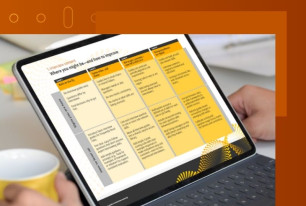6 Best Practices for Harnessing the Power of AI in Talent Assessment
Artificial Intelligence is changing talent assessment, and we have the science and expertise to guide you through this evolving landscape.
Share
I consider myself a bit of a skeptic, with a keen “nonsense” detector. And when it comes to Artificial Intelligence (AI) in HR, there is certainly a lot of hype floating around – hype that can cause near-panic-levels of FOMO and send people scrambling in all directions. However, I have also worked alongside SHL data scientists and computer engineers for the past four years, conducting research on the use of Natural Language Processing (Meaden & Kind, 2019; Meaden & Kropp, 2018) and Machine Learning (Bekera, Meaden, & Lee, 2019) – two subcategories of AI – in enhancing talent outcomes, and developing AI-based assessments (SHL Application Analytics).
From this experience, I have become convinced of two things:
- That AI has the potential to radically transform talent assessment
- That expertise from talent assessment professionals (e.g., I/O psychologists) is required if AI will ever live up to its hype
I truly believe that the benefits that AI promises for talent assessment can only be achieved through the close collaboration between experts in both AI and talent assessment. There is a real synergy to be achieved via the combination of AI’s bottom-up approach to predicting outcomes with the more top-down approach taken by talent assessment professionals – together, they are better.
For example, while the power of AI can be used to identify complex relationships between the words spoken during a video interview and an important outcome or construct, talent assessment experts can help to ensure that this outcome or construct is well measured, is related to performance on the job, is legally defensible, and explainable within the context of talent assessment’s existing body of knowledge.
The path ahead will be challenging. We are currently in the early stages of the “AI Revolution”, and there exists some uncertainty and confusion regarding the appropriate use of AI in talent assessment, and on top of that the legal regulations governing its use are still evolving. This lack of clarity and guidance leaves some organizations interested in using AI, but unsure of where to start and what they need to consider. They may have questions such as –
What are the benefits of AI in assessment?
What are the risks?
How can I evaluate an AI assessment?
– but find it difficult to get straightforward answers.
What the field of talent assessment needs is a strong set of guidelines that bring clarity to these questions and provide recommended procedures for developing and/or using AI to assess talent.
Cue SHL.
During key periods in the history of talent assessment, when technological advances have had a significant impact on the field, SHL has repeatedly led the way in providing clarity and guidance to the community of talent assessment professionals1. In a continuation of this trend, we have leveraged our deep expertise in talent assessment2 and AI3 to develop the needed guidelines and best practice recommendations for using AI in talent assessment.
SHL’s Best Practices for the Ethical and Effective use of AI to Assess Talent build upon the best practices within AI and talent assessment and are aligned with currently existing legal regulations. The Best Practices are intended for HR practitioners, I/O Psychologists, and other talent program owners who are interested in applying AI to assess candidates and/or employees.
Learn about best practices for AI in talent assessment.
An HR function that aims to successfully harness the power of AI and enhance the assessment of talent, while mitigating the associated risks, will need guidance through the currently complex and shifting landscape. Use our Best Practices to chart your course to success.
Endnotes
1 For example: 1) how to use competencies in testing (Bartram, 2005); 2) best practices for unproctored internet testing (Beaty, Dawson, Fallaw, & Kantrowitz, 2009); 3) techniques for cheating prevention in online cognitive ability testing (Burke, 2009); 4) the validity of unproctored internet testing (Beaty, et al., 2011); 5) device-equivalent mobile-first cognitive ability assessments (Grelle & Gutierrez, 2019).
2 SHL is one of the largest private-sector employers of I/O psychologists
3 SHL recently acquired Aspiring Minds, a provider of AI-powered assessments [https://www.shl.com/about/news-and-events/press-releases/shl-acquisition-of-aspiring-minds-signals-the-next-generation-of-talent-strategy-is-here/]
References
Bartram, D. (2005). The great eight competencies: A criterion-centric approach to validation. Journal of Applied Psychology, 90(6), 1185-1203.
Beaty, J. C., Dawson, C. R., Fallaw, S. S., & Kantrowitz, T. M. (2009). Recovering the scientist–practitioner model: How IOs should respond to unproctored internet testing. Industrial and Organizational Psychology, 2(1), 58-63.
Beaty, J. C., Nye, C. D., Borneman, M. J., Kantrowitz, T. M., Drasgow, F., & Grauer, E. (2011). Proctored versus unproctored internet tests: Are unproctored noncognitive tests as predictive of job performance? International Journal of Selection and Assessment, 19(1), 1-10.
Bekera, B., Meaden, J., & Lee, S. (April, 2019). It’s About Time: Using Survival Analysis to Gain Time-Based People Insights [Conference tutorial]. Society for Industrial and Organizational Psychology conference, Washington, DC.
Burke, E. (2009). Preserving the integrity of online testing. Industrial and Organizational Psychology, 2(1), 35-38.
Grelle, D. M., & Gutierrez, S. L. (2019). Developing Device-Equivalent and Effective Measures of Complex Thinking with an Information Processing Framework and Mobile First Design Principles. Personnel Assessment and Decisions, 5(3), 21-32.
Meaden, J., & Kind, C. (April, 2019). Applied NLP in Organizational Research [Conference seminar]. Society for Industrial and Organizational Psychology conference, Washington, DC.
Meaden, J., & Kropp, A. (April, 2018). Application-Based Text Analysis as a Complement to Psychometric Assessments [Conference presentation]. Society for Industrial and Organizational Psychology conference, Chicago, IL.









